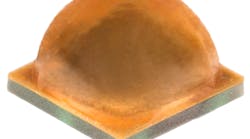JIANZHONG JIAO explains the expanded scope of the new LM-80 standard with coverage of color along with white LEDs and test methods defined specifically for DC high-voltage, AC, and other variants of the simple discrete LED.
The IES LM-80 standard is a document developed by the Illuminating Engineering Society of North America Testing Procedures Committee (IES TPC). Its purpose is to provide uniform testing methods to obtain information on LED luminous flux and chromaticity changes, and allow a reliable comparison of LED characteristics when comparing products from different manufacturers with test results from different laboratories. But the LED landscape has shifted considerably with new types of component architectures, and new solid-state lighting (SSL) product development concepts such as tunable luminaires. The IES TPC has therefore worked to revise LM-80 to ensure it serves the intended purpose given the current state of LED and SSL technology.
LM-80 data is critical for LED users to evaluate long-term light output change behavior. Originally published in 2008, IES LM-80 is widely used by the LED lighting industry worldwide. After years of conducting luminance flux and color maintenance LED tests, LED makers, users, and independent test laboratories have gained significant experience and knowledge. Still, the aforementioned evolution in LEDs led an IES TPC working group to revise LM-80 and the new version is currently being reviewed by the IES Board. The revisions and added scope generally fall into four areas.
Areas of change
The first change is to clarify the scope of the document. The testing methodology established applies to LED packages, arrays, and modules for all ranges of light radiation. It includes both wideband and narrowband, such as white-colored, single-colored, or UV LEDs. Depending on the LED application - illumination, plant growth, etc. - tested characteristics include luminous flux, radiant flux, and photon flux. The wavelength characteristics can be chromaticity, peak wavelength, centroid, or dominant wavelength.
The second change is to expand procedures to cover AC, high-voltage DC, and pulsewidth-modulation (PWM) drive LEDs. Drive levels will replace drive current requirements, and will be specified as the operational requirements for DC constant-current drive, PWM drive, DC constant-voltage drive, and AC regulated-voltage drive. With LED technology changes, the DC constant-current drive is no longer the only drive mode. All other types of drive modes should be tested with the new version of LM-80.
The third change is the required number of case temperatures, reflected in IES LM-80 Addendum A. When IES LM-80 was first published, experts believed that for projecting long-term luminous flux behavior, three temperatures were needed for test data. With the development of IES TM-21 for projecting lumen maintenance in 2010, experts agreed the projecting method should use the trend (over a sufficient period of time) of single case temperature testing data.
Related article: IES updates LED Lumen Maintenance document
There is a separate projection method in TM-21 based on using two tested case temperatures and interpolating data between the tested case temperatures. Thus, the requirement of testing three case temperatures does not serve any practical purpose and it leads to unnecessary testing burden on LED manufacturers. The committee decided that IES LM-80 should not specify which case temperature will be mandatorily tested. The updated LM-80 will use the same language in Addendum A: "At least one of the selected case temperatures shall be 55°C or 85°C. These case temperatures are commonly used for industry testing to support direct product comparisons of testing results."
Test duration
The final change is a major one regarding the test duration, which going forward will be specified solely in TM-21. Let's consider the history of the IES TPC and current thinking to understand why.
The current version of IES LM-80 requires minimum maintenance test duration of 6,000 hours in order to obtain sufficient data for making long-term projections. Experts have conducted numerous studies over the years to determine the shortest testing duration, as well as data collecting measurement intervals. Findings showed that projection time length is largely dependent on the number of samples used for the test and test duration, and the measurement interval is less dependent. The studies also indicated that data collected in 6,000 hours provides a sufficient statistical certainty for the projection. The test duration and measurement interval findings led in part to the establishment of TM-21, in which the LM-80 data is being used for projection purposes.
Related article: Using LM-80 measurement methodology to determine the true value of packaged LEDs
The purpose of an LM document is to provide a standard method of measurement. The method should be focused on testing procedures such as conditions, operations, and data collection methodologies. The IES TPC conducted an internal survey and reached a consensus on what content should be put into the LM and TM documents. Since 2008, the IES TPC has developed a series of "paired" documents for testing and projecting luminous flux for component level (LED packages, modules, remote phosphors, etc.) and final product level (LED lamps, engines and luminaires). These paired documents include IES LM-80 and IES TM-21; IES LM-84 and IES TM-28; and IES LM-86 and IES TM-29.
TM documents define duration
The TM documents will define LM test duration going forward, and will do so in the context of the period for which a projection is statistically valid. The change is being made in order to maintain the consistency within IES TPC developed documents. For the method of measurement documents or the LMs, they will not specify the test duration and measurement interval because the test methods are valid for any test duration. In order to use the test data to make projections statistically reliable, the test duration and measurement interval will be specified in the paired TM documents.
The work done by the IES TPC is highly recognized by the LED industry. The new version of LM-80 will not specify the test duration and measurement interval. These parameters are at the discretion of the users of the document. Specifically, the IES LM-80 will have a statement: "The maintenance test duration and measurement intervals shall be based on, and consistent with, the design operating life, the intent of the test including evidence of compliance to the regulations requested and planned analysis of the data (e.g. data for predictive luminous flux maintenance modeling, or data for actual luminous flux maintenance validation)."
The revisions to IES LM-80 will make the document more robust, consistent, and technically sound. It will undergo the ANSI accreditation process and become an ANSI standard when it is published, providing higher credentials and legitimacy for the US federal or local government agencies to refer to or adopt as regulations. An ANSI standard can also be officially introduced into the international standards community as publically available specifications and possibly be adopted as an international standard.
DR. JIANZHONG JIAO, director of regulations and emerging technologies at OSRAM Opto Semiconductors, Inc., is an internationally recognized lighting expert. He has been actively involved in LED and SSL standard development activities. He serves as the past chairman of the SAE Lighting Committee, past chairman of NGLIA, past chairman of the NEMA SSL Technical Committee, active member of IESNA Testing Procedure Committee, Roadway Lighting Committee, and Computer Committee, ANSI SSL Working Groups, Standard Technical Panel of UL8750, standard committees in IEEE, CIE USA, SEMI, JEDEC and other organizations. He can be reached at [email protected].







